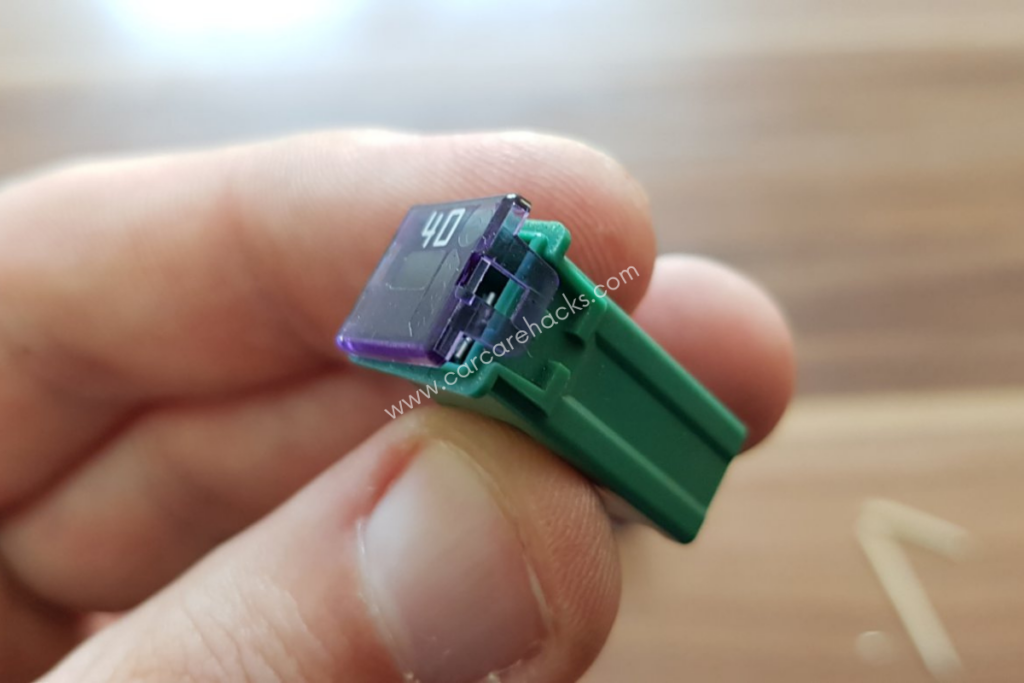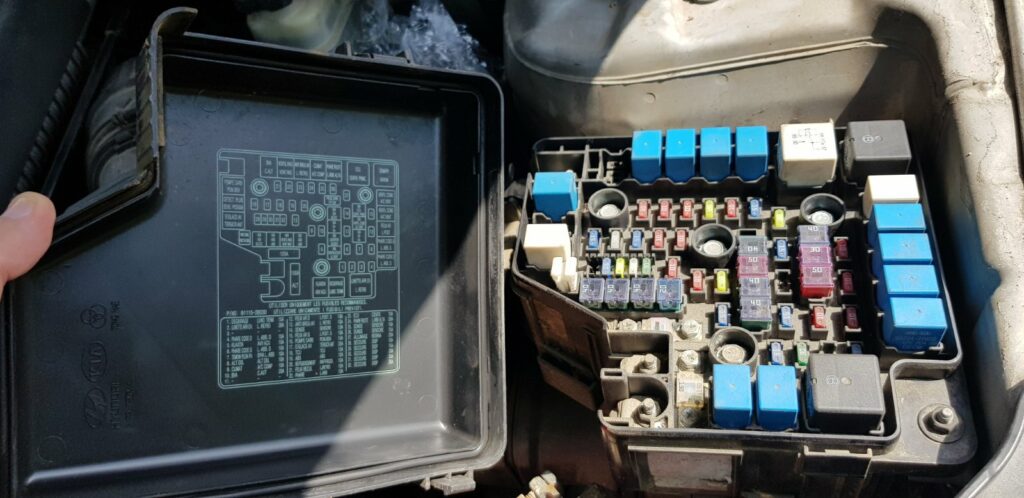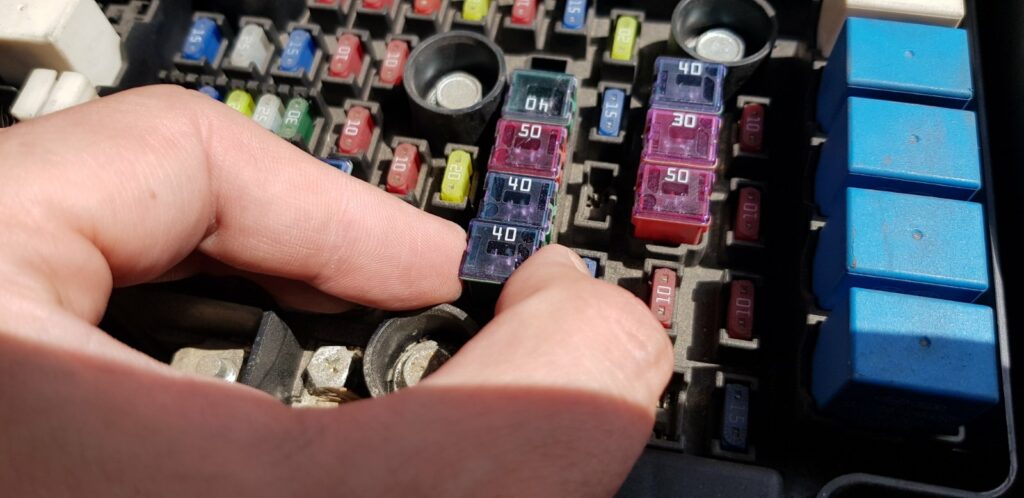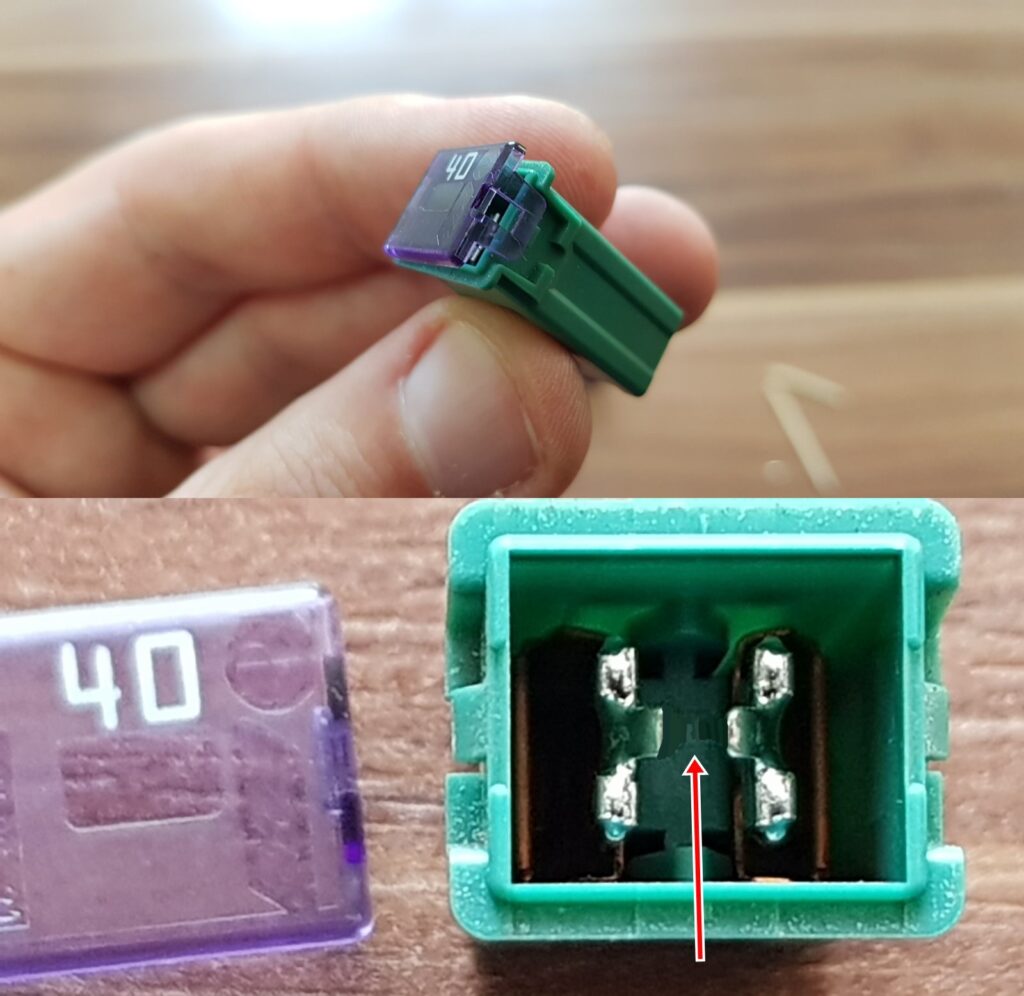Despite the size of the fuses in vehicles, they do play an important role. Like all parts in the vehicle, fuses have an expiration date. They get blown when being exposed to a high current in order to prevent that current from traveling to the main component and damaging it.
Basically, fuses are in the first line of defense and they take the hit so the main component doesn’t get burnt. Each vehicle has a few 40 amp fuses that protect many important components.
But, what does a blown 40 amp fuse look like? How can you tell when you need to change your 40 amp fuse?
In this article, I am going to talk about what is the 40 amp fuse used for, what a blown 40 amp fuse looks like, and how to replace a blown 40 amp fuse.
Key Takeaway
- You can tell that a 40 amp fuse is blown if you visually inspect it. The fuse wire that is supposed to allow current to flow through it will appear melted/broken.
- You can tell that a 40 amp fuse is blown by visually inspecting it. Remove the plastic top cover and check for damage to the fuse wire. If the 40 amp fuse is blown, the fuse wire will look like a broken bridge between the two copper contacts.
What Is The 40 Amp Fuse Used For In Cars

The 40 amp fuse is used in vehicles to protect components from overcurrent and short-circuiting that require 40 amps to operate.
This includes the ABS system, ignition, ECU, window regulator mechanisms, and AC fans. When some of the components draw a stronger current than it is designed to handle, the 40 amp fuse gets blown in order to stop the current from traveling to the main component and burning it.
Basically, the larger the amperage, the more important and expensive the component is. So, instead of expensive components getting burned by drawing higher currents each time they malfunction, vehicle manufacturers came up with a $2 40 amp fuse that will get blown instead of the main component.
Today’s vehicles can contain up to 100 ECUs, maybe more. Each of the electronic control units has been designed for a specific job including ABS, power steering control, the way to power windows, seat heaters, and AC. There isn’t room in the fuse box for each ECU, so many of them are protected by the same 40 amp fuse.
So, when some of these ECUs malfunction, they tend to draw more current from the battery than they are designed to withstand. When this happens, the current travels from the car battery, into the 40 amp fuse. The 40 amp fuse detects that the current is too strong and instantly gets blown.
This action stops the high current from reaching the next stop which is the main component. By doing so, the 40 amp fuse protects the main components from getting burnt.
What Does a Blown 40 Amp Fuse Look Like

A blown 40 amp fuse is characterized by a broken or disconnected metal alloy strip or thin wire inside the fuse, often with signs of burning or discoloration.
When a 40 amp fuse gets blown, the metal alloy strip or thin wire inside will look like it is broken. The 40 amp fuse has copper contacts on both sides and a metal alloy strip or thin wire running from one copper contact to the other. When the 40 amp fuse gets blown from a high current, the fuse wire in the middle of the cartridge melts and prevents further electricity flow.
A 40 amp fuse is designed to withstand 40 amps of electricity. If for some reason a higher current is being drawn from the main component, the 40 amp fuse will get blown and prevent the main component from being damaged. A properly working 40 amp fuse has a metal alloy strip that acts like a bridge between two copper contacts.
When current comes from the car battery, it enters one copper contact and then flows through the metal alloy strip, into the other copper contact, and to the main component.
However, when a higher-than-normal current is being drawn from the car battery, the high current will enter one copper contact, but the metal alloy strip will melt.
No current will flow into the other copper contact and into the main component. By doing this, the 40 amp fuse prevents further damage to the main component says Piston Heads.
Symptoms of a Blown 40 Amp Fuse
- Loss of Power: The electrical component or system protected by the fuse will stop working.
- Warning Lights: In some vehicles, a warning light on the dashboard may illuminate.
- Frequent Fuse Failure: If the same fuse keeps blowing repeatedly, it’s likely there is an underlying issue.
- Smoke or Burn Smell: In severe cases, a blown fuse may produce a faint smell of burning or smoke.
- Visual Signs: Upon inspection, the fuse may show signs of damage, such as a broken wire or discoloration.
How To Replace a Blown 40 Amp Fuse
- Order a new 40 amp fuse.
- Open the hood and locate the fuse box.
- Open the fuse box and locate the blown 40 amp fuse.
- Remove the blown 40 amp fuse.
- Visually inspect the 40 amp fuse to verify that it is blown.
- Install the new 40 amp fuse.
- Close the fuse box and the hood.
Replacing a blown 40 amp fuse can save you a lot of money. For example, a new 40 amp fuse costs around $2, but you can get charged up to $100 in a repair shop. So, instead of wasting money, here is how to replace a blown 40 amp fuse:
1. Order a new 40 amp fuse

Before you start the replacement task, you will need to get a new 40 amp fuse. The 40 amp fuses are so cheap that I just ordered a bulk of 10 online. Here is a 10-pack of 40 amp fuses on amazon.com. Just make sure that you get the exact same as your blown fuse.
There are blade-style and cartridge-style 40-amp fuses. Also, do not try to install a fuse with a different amperage as it will get blown immediately.
2. Open the hood and locate the fuse box

Some vehicles can have fuse boxes in multiple locations. The most common locations for fuse boxes are underneath the steering wheel and under the hood. However, the 40 amp fuses are usually located under the hood. You can always check the owner’s manual to learn more about your vehicle’s fuses.
Pull the latch and open the hood. The fuse box is usually located on the right side of the engine, next to the battery. On many vehicles, the fuse box will be labeled.
3. Open the fuse box and locate the faulty 40 amp fuse

To open the fuse box, you will need to pull the clip or tab and slowly remove the lid. There is a diagram on the fuse box lid that will help you easily locate the 40 amp fuse. As you can see, there can be multiple 40-amp fuses, so if you are not sure which one is blown, you can replace them all.
4. Remove the blown 40 amp fuse

There are a couple of ways to remove a blown 40 amp fuse. The method will depend on how badly the fuse is blown. In some cases, you might find a completely melted fuse. In that scenario, I would disconnect the battery before moving forward.
If only the fuse wire is blown, you can remove that fuse with your hands. If it’s stuck, you can go ahead and use pliers. However, be careful not to break the fuse in two and end up with half the fuse stuck into the port. As far as a completely melted fuse, I would use gloves and pliers. Make sure to remove all of the pieces before installing a new fuse.
5. Visually inspect the blown 40 amp fuse

A blown 40 amp fuse can be a little bit tricky to visually inspect because it sits in a cartridge. So, to gain access and a better look, open the lid of the cartridge. To do this, you will need a toothpick. Push the tabs on each side of the cartridge and slowly pull the lid.
At this point, you can actually see if the 40 amp fuse is indeed blown. The metal alloy strip that runs from one copper contact to another has to be intact. If that ”bridge” looks like it’s disconnected, the fuse is blown. However, it’s not always this easy to visually inspect a blown fuse.
Sometimes, the metal alloy strip tends to break in a hard-to-see place. So, that is why you should also check it with a multimeter.
6. Test the blown 40 amp fuse with a multimeter

Turn on your multimeter and set it on Ohms. Before you go ahead and test the blown 40 amp fuse, make sure to calibrate the multimeter first. Touch the red and black wires of the multimeter. If you get the same reading (1 in my case) when you touch the two wires and after that when you test the fuse, it will mean that the fuse is working properly.
However, if you get a reading of 1 ohm when you touch the wires, but then get a completely different reading when you test the 40 amp fuse, it means that the fuse is blown. I always like to test the fuses with a multimeter because sometimes they are not blown as I think, or they are blown but in a hard-to-see spot.
To actually test the 40 amp fuse with a multimeter, you need to insert the wires on the backside of the fuse, into the copper contacts, one wire per copper contact.
7. Install the new 40 amp fuse and close the fuse box

Install the brand new 40 amp fuse into the same slot that you pulled out the blown one. Make sure that there is no dirt and debris in the fuse port. Then, go ahead and close the fuse box and press it down until you hear the tabs click.
What Causes a Blown 40 Amp Fuse
- Overcurrent: If the current flowing through the fuse exceeds its rated capacity (40 Amps in this case), it can cause the fuse to blow.
- Short Circuit: A direct connection between the positive and negative terminals, bypassing the normal load, can cause a sudden surge of electricity, leading to a blown fuse.
- Aged or Worn Out Fuse: Over time, fuses can deteriorate and become more susceptible to blowing, even under normal electrical conditions.
- Faulty Electrical Components: If an electrical device or component connected to the circuit is faulty, it can draw excessive current and blow the fuse.
- Incorrect Fuse Rating: If a fuse with an incorrect rating has been used, it may not be able to handle the load and could blow.
How Much Is A 40 Amp Fuse
A 40 amp blade-style fuse costs $1 and a cartridge-style 40 amp fuse costs around $1.5 per fuse. These prices are from Amazon. However, you can also check your local auto part stores or even a gas station. Buying fuses in bulk is even cheaper.
FAQs
Q: How can I identify if a 40 amp fuse is blown?
A: To identify if a 40 amp fuse is blown, you can visually inspect the fuse element inside the fuse housing. If the element appears broken or burnt out, then the fuse is most likely blown.
Q: Can a blown 40 amp fuse cause a complete power failure?
A: Yes, a blown 40 amp fuse can cause a complete power failure in the circuit it protects. When a fuse blows, it opens the circuit and stops the flow of electricity.
Q: How can I replace a blown 40 amp fuse?
A: To replace a blown 40 amp fuse, you need to first identify the location of the fuse in your electrical system. Once located, you can carefully pull out the blown fuse and replace it with a new one that has the same ampere rating.
Q: Are there any safety precautions I should take when dealing with blown fuses?
A: Yes, it is important to take safety precautions when dealing with blown fuses. Always disconnect the power source before replacing a fuse, and use insulated tools to avoid electrical shock.
Q: Can a blown 40 amp fuse be caused by an electrical overload?
A: Yes, an electrical overload can cause a blown 40-amp fuse. When the current flowing through a circuit exceeds the fuse’s rating, the fuse will blow to protect the circuit from damage.
Q: Are there any specific tools required to replace a blown 40 amp fuse?
A: Generally, no specific tools are required to replace a blown 40 amp fuse. However, it is recommended to have a fuse puller or a pair of needle nose pliers to safely remove the fuse.
Q: Can I use a higher ampere-rated fuse to replace a blown 40 amp fuse?
A: No, it is not recommended to use a higher ampere-rated fuse to replace a blown 40 amp fuse. Fuses are designed to protect the electrical circuit and using a higher rated fuse can potentially cause damage or overheating.
Q: Should I consult a professional if I am unsure about replacing a blown 40 amp fuse?
A: If you are unsure about replacing a blown 40 amp fuse, it is recommended to consult a professional electrician. They have the knowledge and expertise to safely handle electrical systems and can ensure proper fuse replacement.
In Conclusion
A blown 40 amp fuse will often look visibly different from a working one. The metal filament inside the fuse will be burned, and the glass tube may be cracked or melted.
Additionally, you may smell burning plastic or see charring near the terminals of the fuse if it has been exposed to excessive current.
